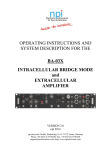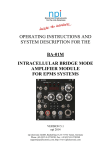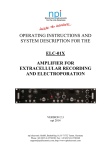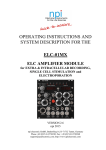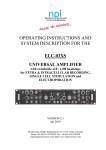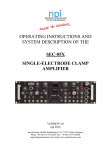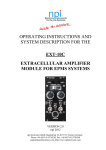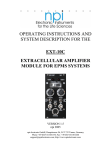Download BA-01X manual ver1_9 - NPI Electronic Instruments
Transcript
OPERATING INSTRUCTIONS AND SYSTEM DESCRIPTION FOR THE BA-01X INTRACELLULAR BRIDGE MODE AMPLIFIER VERSION 1.9 npi 2014 npi electronic GmbH, Bauhofring 16, D-71732 Tamm, Germany Phone +49 (0)7141-9730230; Fax: +49 (0)7141-9730240 [email protected]; http://www.npielectronic.com BA-01X User Manual _________________________________________________________________________________________________________________ Table of Contents About this Manual ................................................................................................................... 3 1. Safety Regulations .............................................................................................................. 4 2. BA-01X Components ......................................................................................................... 5 3. BA-01X System .................................................................................................................. 5 3.1. System Description ...................................................................................................... 5 3.2. Description of the Front Panel ..................................................................................... 6 3.3. Description of the Rear Panel ...................................................................................... 15 4. Headstage ............................................................................................................................ 16 4.1. Headstage Elements ..................................................................................................... 16 5. Setting up the BA-01X ....................................................................................................... 17 6. Passive Cell Model ............................................................................................................. 18 6.1. Cell Model Description ............................................................................................... 18 6.2. Connections and Operation ......................................................................................... 19 7. Test and Tuning Procedures ............................................................................................... 21 7.1. Headstage Bias Current Adjustment ........................................................................... 21 7.2. Offset Compensation ................................................................................................... 22 7.3. Capacitance Compensation.......................................................................................... 22 7.4. Bridge Balance ............................................................................................................ 24 7.5. Electrode Selection ...................................................................................................... 24 8. Sample Experiments ........................................................................................................... 26 8.1. Sample Experiment using a Sharp Electrode .............................................................. 26 8.2. Sample Experiment using a Suction (Patch) Electrode ............................................... 29 9. Trouble Shooting ................................................................................................................ 31 10. Literature ..................................................................................................................... 32 11. Technical Data ............................................................................................................. 35 Index ........................................................................................................................................ 37 ___________________________________________________________________________ version 1.9 page 2 BA-01X User Manual _________________________________________________________________________________________________________________ About this Manual This manual should help to setup and use the BA-01X system correctly and to perform reliable experiments. If you are not familiar with the use of instruments for intracellular recording of electrical signals please read the manual completely. The experienced user should read at least chapters, 1, 3, 3.3, 0 and 7. Important: Please read chapter 1 carefully! It contains general information about the safety regulations and how to handle highly sensitive electronic instruments. Signs and conventions In this manual all elements of the front panel are written in capital letters as they appear on the front panel. System components that are shipped in the standard configuration are marked with ✓ , optional components with ➪. In some chapters the user is guided step by step through a certain procedure. These steps are marked with ❏. Important information and special precautions are highlighted in gray. Abbreviations Cm: cell membrane capacitance Cstray: electrode stray capacitance GND: ground Imax: maximal current Rm: cell membrane resistance REL: electrode resistance τCm: time constant of the cell membrane VREL: potential drop at REL ___________________________________________________________________________ version 1.9 page 3 BA-01X User Manual _________________________________________________________________________________________________________________ 1. Safety Regulations VERY IMPORTANT: Instruments and components supplied by npi electronic are NOT intended for clinical use or medical purposes (e.g. for diagnosis or treatment of humans), or for any other life-supporting system. npi electronic disclaims any warranties for such purpose. Equipment supplied by npi electronic must be operated only by selected, trained and adequately instructed personnel. For details please consult the GENERAL TERMS OF DELIVERY AND CONDITIONS OF BUSINESS of npi electronic, D-71732 Tamm, Germany. 1) GENERAL: This system is designed for use in scientific laboratories and must be operated only by trained staff. General safety regulations for operating electrical devices should be followed. 2) AC MAINS CONNECTION: While working with npi systems, always adhere to the appropriate safety measures for handling electronic devices. Before using any device please read manuals and instructions carefully. The device is to be operated only at 115/230 Volt 60/50 Hz AC. Please check for appropriate line voltage before connecting any system to mains. Always use a three-wire line cord and a mains power-plug with a protection contact connected to ground (protective earth). Before opening the cabinet, unplug the instrument. Unplug the instrument when replacing the fuse or changing line voltage. Replace fuse only with an appropriate specified type. 3) STATIC ELECTRICITY: Electronic equipment is sensitive to static discharges. Some devices such as sensor inputs are equipped with very sensitive FET amplifiers, which can be damaged by electrostatic charge and must therefore be handled with care. Electrostatic discharge can be avoided by touching a grounded metal surface when changing or adjusting sensors. Always turn power off when adding or removing modules, connecting or disconnecting sensors, headstages or other components from the instrument or 19” cabinet. 4) TEMPERATURE DRIFT / WARM-UP TIME: All analog electronic systems are sensitive to temperature changes. Therefore, all electronic instruments containing analog circuits should be used only in a warmed-up condition (i.e. after internal temperature has reached steady-state values). In most cases a warm-up period of 20-30 minutes is sufficient. 5) HANDLING: Please protect the device from moisture, heat, radiation and corrosive chemicals. ___________________________________________________________________________ version 1.9 page 4 BA-01X User Manual _________________________________________________________________________________________________________________ 2. BA-01X Components The following items are shipped with the BA-01X system: ✓ ✓ ✓ ✓ ✓ BA-01X amplifier Headstage Ground connector for headstage (2.6 mm) Power cord User manual Optional accessories: ➪ ➪ ➪ ➪ ➪ ➪ ➪ ➪ Electrode holder Suction (patch) electrode holder Electrode holder adapter for mounting to a micromanipulator Remote switch for penetration unit Active cell model Passive cell model (see Figure 7) Low noise / low bias current headstage with a reduced current range (:10 headstage, i.e. maximal current is 1.2 nA or 12 nA respectively) Headstage with differential input 3. BA-01X System This manual is related to the standard configuration of the BA-01X system consisting a standard headstage and standard calibrations of bridge balance, electrode resistance display range etc. Other configurations are available, e.g. if the BA-01X system is used only for whole cell patch clamp recordings with suction electrodes the BA-01X system can be delivered with adapted calibrations and a low noise / low bias current headstage (see Optional accessories in chapter 2). For details contact npi. 3.1. System Description The npi BA-01X intracellular recording systems are precise current clamp instruments with a bridge circuit to compensate for the resistance of the recording intracellular electrode. For current injection and potential recording a very high impedance voltage-to-current converter with a special input capacitance compensation circuit is used. For methodical reviews see Lalley et al. (1999), Richter et al. (1996), Ogden (1994) and Boulton et al. (1990). ___________________________________________________________________________ version 1.9 page 5 BA-01X User Manual _________________________________________________________________________________________________________________ The system consists of standard desktop cabinet and a headstage which should be placed close to the recording site. The recording electrode is connected to the headstage via an electrode holder (see also Figure 6). In some setups there is no space for placing the headstage very close to the recording site. In that case the electrode holder can be connected to the headstage via an electrode adapter (see Optional accessories in chapter 2). All electrode connectors use a driven shield approach (for details of this approach see Ogden (1994)) to minimize the effect of the connecting cables. In addition, all headstages are equipped with a ground connector providing system ground. The standard system is equipped with a headstage capable of injecting a maximal current of approximately ±12 nA (±120 nA) into a resistance of 100 MΩ (10 MΩ) dependent on the preset current range. With this headstage the system can be used either with high resistance electrodes for intracellular recordings or with low resistance suction electrodes for whole cell patch clamp recordings. To cover all the needs of electrophysiological research all systems have a large variety of operation- and control elements such as cell penetration mode (BUZZ), ELECTRODE CLEAR facility, ten-turn controls for BRIDGE BALANCE, CAPACITANCE COMPENSATION, OFFSET and HOLDING CURRENT, an automated electrode resistance test, digital displays for potential, current and electrode resistance, a GATE and linear CURRENT STIMULUS INPUT. An extended CURRENT RANGE x10 allows electroporation of single cells for non-invasive, juxtacellular filling of cells with dyes or plasmids. 3.2. Description of the Front Panel In the following description of the front panel elements each element has a number that is related to that in Figure 1. The number is followed by the name (in uppercase letters) written on the front panel and the type of the element (in lowercase letters). Then, a short description of the element is given. Some elements are grouped in functional units (e.g. BUZZ unit) and are described as units regardless of the order of numbers. ___________________________________________________________________________ version 1.9 page 6 BA-01X User Manual _________________________________________________________________________________________________________________ Figure 1: BA-01X front panel view (the numbers are related to those in the text below) ___________________________________________________________________________ version 1.9 page 7 BA-01X User Manual _________________________________________________________________________________________________________________ (1) POWER pressure switch Switch to turn POWER on (switch pushed) or off (switch released). (2) POTENTIAL / RESISTANCE display Display for the recorded potential in mV (XXX mV) or the electrode resistance in MΩ (XXX MΩ, i.e. 100 correspond to 100 MΩ), selected by push button (31). (3) MΩ LED LED indicating that the unit of display (2) is MΩ. (4) mV LED LED indicating that the unit of display (2) is mV. OSCILLATION SHUT-OFF unit The OSCILLATION SHUT-OFF unit consists of (5) OSCILLATION SHUT-OFF LED, (6) DISABLED/RESET switch and the (30) THRESHOLD potentiometer. (5) OSCILLATION SHUT-OFF LED Indicates whether the OSCILLATION SHUT-OFF circuit is active (LED: red) or not (LED: green). (6) DISABLED/RESET switch Switch to DISABLE the OSCILLATION SHUT-OFF unit or RESET the circuit. RESET is for resetting the circuit after previous activation. After resetting the OSCILLATION SHUT-OFF unit is active again. (30) THRESHOLD potentiometer Control to set the activation THRESHOLD of the OSCILLATION SHUT-OFF circuit (potentiometer, linear clockwise, range: 0-1200 mV). Note: If the OSCILLATION SHUT-OFF unit is active, the output of the amplifier to the headstage is disabled. Potential measurement works. ___________________________________________________________________________ version 1.9 page 8 BA-01X User Manual _________________________________________________________________________________________________________________ Important: The capacity compensation for the electrode does NOT work if the oscillation shut-off circuit is activated. This may lead to an incorrect reading of the electrode resistance (see also 31) especially when electrodes with high resistances are used. (8) CURRENT (nA) display Display for the electrode current in nA. Scaling is dependent on the position of the CURRENT RANGE switch (9) x1: XX.XX nA, x10: XXX.X nA CURRENT RANGE unit The CURRENT RANGE unit consists of (9) CURRENT RANGE LED and (10) CURRENT RANGE switch. (9) CURRENT RANGE LED LED indicating the actual current range of the amplifier. LED ON: BA-01X is in x10 range LED OFF: BA-01X is in x1 range (10) CURRENT RANGE switch Switch for setting the current range of the amplifier: x1: max. ±12 nA into 1 GΩ, x10: max. ±120 nA into 100 MΩ HOLDING CURRENT unit The HOLDING CURRENT unit consists of (12) HOLDING CURRENT (nA) potentiometer and (12) + / 0 / - switch (holding current switch). (11) HOLDING CURRENT (nA) potentiometer Control for generating a constant current (holding current), (ten turn potentiometer, clockwise), calibrated in nA (Imax = 10 nA in x1 current range or 100 nA in x10 current range). The polarity of this holding current is set by toggle switch (12). (12) + / 0 / - switch (holding current switch) Switch to disable holding current generation or to set the polarity of the holding current (+: current positive, 0: holding current disabled, -: current negative). ___________________________________________________________________________ version 1.9 page 9 BA-01X User Manual _________________________________________________________________________________________________________________ (13) BIAS (bias current) potentiometer Potentiometer for cancellation of the output current (BIAS current) of the (headstage) (ten-turn potentiometer, symmetrical, i.e. 0 pA = 5 on the dial), range: current range x1 and x10: ±200 pA (see chapter 7.1). PENETRATION unit The PENETRATION unit consists of (14) ELECTR.CLEAR switch, (15) BUZZ push button, (19) BUZZ DURATION potentiometer and (20) BUZZ REMOTE connector. (5) ELECTR.CLEAR switch Momentary switch for activating the ELECTRODE CLEAR circuit that can be used to clean the tip of the electrode by passing large amounts of positive or negative currents. The circuit is operated by pushing the switch to +Imax (maximum positive current) or -Imax (maximum negative current). The maximum current is dependent on the setting of the current range, see also (10). (15) BUZZ push button Push button to activate the BUZZ circuit (duration set by (19)). To facilitate the penetration of the cell membrane the BUZZ circuit is provided, which is based on oscillations caused by overcompensating the capacitance compensation system. This yields to very powerful high-frequency oscillations (see Figure 2). (19) BUZZ DURATION potentiometer Control to set the duration of the BUZZ (potentiometer, clockwise, range: ~1 ms to ~100 ms). The duration is also slightly dependent on the setting of CAPACITY COMP. (17). It is effective in both modes (REMOTE and BUZZ), see also (20). (20) BUZZ REMOTE connector BNC connector for operating the BUZZ circuit remotely. The remote device is connected via a grounded BNC cable. The duration of the BUZZ is dependent on the setting of the BUZZ DURATION potentiometer (19). potential (mV) 12000 8000 4000 0 -4000 -8000 -12000 start stop time (ms) Figure 2: buzz function of the BA-01X ___________________________________________________________________________ version 1.9 page 10 BA-01X User Manual _________________________________________________________________________________________________________________ (16) OFFSET potentiometer Control to set the output of the electrode preamplifier to zero (ten-turn potentiometer, symmetrical, i.e. 0 mV = 5 on the dial), range: ±200 mV (see chapter 7.2). (17) CAPACITY COMP. potentiometer Control for compensation of the input capacitance (ten turn potentiometer, clockwise, range: 0-30 pF, see chapter 7.3). Caution: This circuit is based on a positive feedback circuit. Overcompensation leads to oscillations which may damage the cell. Important: The capacity compensation for the electrode does NOT work if the oscillation shut-off circuit is activated. This may lead to an incorrect reading of the electrode resistance (see also 31) especially when electrodes with high resistances are used. (18) HEADSTAGE connector The HEADSTAGE is connected via a flexible cable and an 8-pole connector to the mainframe (see also chapter 3.3). Caution: Please always adhere to the appropriate safety regulations (see chapter 1). Please turn power off when connecting or disconnecting the headstage from the HEADSTAGE connector! BRIDGE BALANCE unit The BRIDGE BALANCE unit consists of (21) 100 MΩ / 10 MΩ range switch and (22) BRIDGE BALANCE potentiometer. (21) 100 MΩ / 10 MΩ range switch Switch to set the range of the BRIDGE BALANCE potentiometer (100 MΩ position: 0 MΩ to 1000 MΩ, 10 MΩ position: 0 MΩ to 100 MΩ). (22) BRIDGE BALANCE(MΩ) potentiometer If current is passed through the recording electrode the potential deflection caused at the electrode resistance is compensated with this control (ten turn potentiometer, clockwise, calibrated in MΩ, range: set by switch (21), see also chapter 7.4). ___________________________________________________________________________ version 1.9 page 11 BA-01X User Manual _________________________________________________________________________________________________________________ CURRENT INPUT unit The CURRENT INPUT unit consists of (23) (25) on / off switches, (24) 1 nA/V connector and (26) 0.1 nA/V connector. (23) on / off switch Switch to enable (on) or disable (off) CURRENT INPUT via 1 nA/V connector. To avoid interferences always switch to off position if the INPUT is not used. (24) CURRENT INPUT 1 nA/V connector Analog input BNC connector for application of signals from an external stimulus source. The voltage signal that is connected here is transformed to a proportional current at the electrode with a sensitivity of 1 nA/V, i.e. an input voltage of 5 V is transformed to an output current of 5 nA. The signal form remains unchanged. Two examples are given in Figure 3. The amplitude of the output current signal (current stimulus) is determined by the amplitude of the input voltage signal. input voltage signal output current signal Figure 3: input-output relation using CURRENT INPUT (25) on / off switch Switch to enable (on) or disable (off) CURRENT INPUT via 0.1 nA/V connector. Hint: To avoid interferences always switch to off position if the INPUT is not used. (26) CURRENT INPUT 0.1 nA/V connector Analog input BNC connector for application of signals from an external stimulus source. The voltage signal that is connected here is transformed to a proportional current at the electrode with a sensitivity of 0.1 nA/V, i.e. an input voltage of 5 V is transformed to an output current of 0.5 nA. The signal form remains unchanged (see also (24 and Figure 3). Very Important: If switch #10 is set to x10, all current input signals are multiplied by the factor of 10, i.e. STIMULUS INPUT 1 nA/V is then 10 nA/V and 0.1 nA/V is 1 nA/V, respectively!! Important: The current injected through the electrode is always the sum of the input signal at CURRENT INPUT (24 or 26), the holding current set by HOLDING CURRENT (11) and switch (12), and the gated stimulus set by STEP SIZE (28) and switch (27). ___________________________________________________________________________ version 1.9 page 12 BA-01X User Manual _________________________________________________________________________________________________________________ gated stimulus unit The gated stimulus unit consists of (7) STEP SIZE digital potentiometer, (27) + / 0 / - switch (STEP SIZE switch) and (28) GATE (TTL) connector. (7) STEP SIZE digital potentiometer Digital potentiometer to set the amplitude of the gated stimulus. Range: dependent on the setting of the CURRENT RANGE switch (9). x1: ±9.99 nA, resolution 10 pA; x10: ±99.9 nA, resolution 100 pA. (27) + / 0 / - switch (STEP SIZE switch) + / 0 / - toggle switch to disable the gated stimulus set by STEP SIZE (7) and gated by GATE (TTL) STEP SIZE (28) or to select the polarity of the gated stimulus (+: gated stimulus positive, 0: gated stimulus disabled, -: gated stimulus negative). (28) GATE (TTL) STEP SIZE connector With this input a current step (gated stimulus) can be generated set by the digital potentiometer STEP SIZE (7) and the polarity switch (27). This current step is gated by a positive digital pulse (3-5 V) applied to the BNC connector. Two examples are given in Figure 4. The duration of the current step is determined by the duration of the gating signal. The amplitude of the current step is set by STEP SIZE (7). input voltage signal (>3 V) output current signal Figure 4: input-output relation using GATE (TTL) STEP SIZE (29) CURRENT OUTPUT connector BNC connector monitoring the stimulating current passed through the electrode. (sensitivity: 0.1 V / nA, resistance: 50 Ω). ___________________________________________________________________________ version 1.9 page 13 BA-01X User Manual _________________________________________________________________________________________________________________ (31) ELECTRODE RESISTANCE TEST push button Push button for testing the resistance of the electrode. When this button is pushed DISPLAY (2) shows the electrode resistance in MΩ (see also (3)). The selected mode is indicated by the MΩ LED (3). The resistance is measured accurately regardless of the correct setting of other front panel elements such as OFFSET, BRIDGE BALANCE etc. (see also Important note below). Caution: When the ELECTRODE RESISTANCE push button is pressed, the BA-01X automatically applies current pulses of ±1 nA to the electrode. Therefore, it should not be used during recordings from cells since this current may stimulate or damage the cell. Important: With high resistance electrodes (REL>20 MΩ) the displayed value is dependent on the setting of the capacitance compensation. POTENTIAL OUTPUT unit The OUTPUT unit consists of (32) POTENTIAL OUTPUT FROM HEADSTAGE connector, (33) POTENTIAL OUTPUT GAIN switch and (34) POTENTIAL OUTPUT (mV) connector. (32) POTENTIAL OUTPUT FROM HEADSTAGE connector BNC connector monitoring the recorded membrane potential. This signal is scaled in V and comes directly from the headstage, i.e. it is not amplified. (33) POTENTIAL OUTPUT GAIN switch Switch to set the gain of the POTENTIAL OUTPUT (mV) (34). The measured potential at the electrode tip is multiplied by a factor of 10 (x10) or 100 (x100). (34) POTENTIAL OUTPUT (mV) connector BNC connector monitoring the recorded potential with a gain set by the POTENTIAL OUTPUT GAIN switch (33). (25) GROUND connector Banana jack that is linked to the internal system ground which has no connection to the 19" cabinet and the mains ground to avoid ground loops. ___________________________________________________________________________ version 1.9 page 14 BA-01X User Manual _________________________________________________________________________________________________________________ 3.3. Description of the Rear Panel Figure 5: BA-01X rear panel view (the numbers are related to those in the text below) (1) Mains connector Plug for connecting the BA-01X to mains. (2) Voltage SELECTOR Rotary switch for selecting the mains voltage (110 V-120 V / 220 V-240 V). Caution: Always switch to the appropriate voltage before connecting the BA-01X to power. (3) FUSE holder Holder for the line fuse. For changing the fuse rotate the holder counter clockwise using a screw driver. The appropriate fuse type is listed above the holder. (4) CHASSIS This connector is linked to mains ground (green / yellow wire, protective earth). (5) GROUND This connector is linked to the internal system ground which has no connection to the 19" cabinet (CHASSIS) and the mains ground to avoid ground loops. MODES of OPERATION connectors (6) REL connector BNC connector for connecting a TTL signal that activates the electrode resistance test (see also #31, Figure 1). TTL HI = REL on, TTL LOW = REL off. (7) x10 MODE connector BNC connector for connecting a TTL signal that activates the x10 current mode (see also #10, Figure 1). TTL HI = x10 current mode, TTL LOW = x1 current mode. REMOTE connector (8) BUZZ connector BNC connector for connecting a TTL signal that activates the BUZZ function (see also #20, Figure 1). TTL HI = BUZZ on, TTL LOW = BUZZ off. ___________________________________________________________________________ version 1.9 page 15 BA-01X User Manual _________________________________________________________________________________________________________________ 4. Headstage The BA-01X comes with the standard headstage (range: ±12 nA, voltage range x1 or ±120 nA, voltage range x10) for connecting glass electrodes with high resistances or suction electrodes for whole cell patch clamp recordings with lower resistances via an electrode holder (see Figure 6). A low noise / low bias current headstage (range: ±1.2 nA, voltage range x1 or ±12 nA, voltage range x10, see also Optional accessories in chapter 2) for very small currents is also available. For details contact npi. Figure 6: electrode holder (optional) and headstage of the BA-01X 4.1. 1 2 3 4 Headstage Elements BNC connector for the electrode holder (optional) REF: connector for the reference electrode (differential headstage only GND: Ground connector headstage cable/holding bar The electrode filled with electrolyte is inserted into an electrode holder (optional, see Figure 6) that fits into the BNC connector of the headstage or into an electrode holder adapter (optional, see also Optional accessories in chapter 2). The electrical connection between the electrolyte and the headstage is established using a carefully chlorinated silver wire. Chlorinating of the silver wire is very important since contact of silver to the electrolyte leads to electrochemical potentials causing varying offset potentials at the electrode, deterioration of the voltage measurement etc. (for details see Kettenmann and Grantyn (1992)). For optimal chlorinating of sliver wires an automated chlorinating apparatus (ACl-01) is available (please contact npi for details). Ground provides system ground and is linked to the bath via an agar-bridge or a Ag-AgCl pellet. The headstage is attached to the amplifier with the headstage cable (see #4, Figure 6) and a 8-pole connector. The headstage is mounted to a holding bar that fits to most micromanipulators or optionally to a mounting plate or a dovetail adapter. Note: The shield of the BNC connector is linked to the driven shield output and must not be connected to ground. Caution: Please always adhere to the appropriate safety precautions (see chapter 1). Please turn power off when connecting or disconnecting the headstage from the HEADSTAGE connector! ___________________________________________________________________________ version 1.9 page 16 BA-01X User Manual _________________________________________________________________________________________________________________ 5. Setting up the BA-01X The following steps should help you set up the BA-01X correctly. Always adhere to the appropriate safety measures (see chapter 1). After unpacking, the BA-01X is attached to the setup by assembling the electrical connections. It is assumed that a cell model will be attached. The connection of the Ag-AgCl pellet or the agar-bridge for grounding the bath is described in chapter 8. ➀ Electrical connections ❏ Turn POWER off. ❏ Plug the instrument into a grounded outlet. ❏ Connect the headstage to the HEADSTAGE connector (#18, Figure 1) at the BA-01X. ❏ Connect a cell model (see chapter 6). Connect a digital/analog timing unit or a stimulation device to CURRENT INPUT or to GATE (TTL) STEP SIZE if you intend to use the gated stimulus unit. ❏ Connect a store oscilloscope or a data recording device (i.e. a computer with data acquisition system) to the POTENTIAL OUTPUT and to the CURRENT OUTPUT triggered from the stimulation device. Set the desired gain at the potential range switch (#11, Figure 1). Before using the BA-01X always make the basic settings to avoid oscillations. ➁ Basic settings ❏ Turn all controls to low values (less than 1) and the OFFSET in the range of 5 (zero position, see chapter 3.2). ❏ Set the CURRENT RANGE switch (#10, Figure 1) to x1. ❏ Turn POWER switch on. Now the BA-01X is ready for an initial check with the cell model. ___________________________________________________________________________ version 1.9 page 17 BA-01X User Manual _________________________________________________________________________________________________________________ 6. Passive Cell Model The BA-01X can be ordered with a passive cell model as an optional accessory. An active cell model is also available by request (for ref. see Draguhn et al. (1997)). The passive cell model is designed for use with single electrode amplifiers (BA series, ELC series) to check the function of the instrument in the following circumstances: 1. just after unpacking to see whether the instrument has been damaged during transport or 2. to train personnel using the instrument or 3. in case of trouble (see also chapter 9) to check which part of the setup does not work correctly e.g. to find out whether the amplifier or headstage is damaged or something is wrong with the electrodes or holders etc. The passive cell model consists only of passive elements, i.e. resistors that simulate the resistance of the cell membrane and the electrodes, and capacitances that simulate the capacitance of the cell membrane. A switch allows simulation of two different cell types: a cell with 50 MΩ and 22 pF (CELL 1, represents an astrocyte like cell) or a “small” cell with 200 MΩ membrane resistance and 100 pF membrane capacitance (CELL 1, represents an neuron like cell), or. Electrode immersed into the bath or SEAL formation can be mimicked as well. The headstage of the amplifier can be connected to one of two different types of electrodes (see below). 6.1. Cell Model Description Figure 7: passive cell model 1, 3: 2: 4: 5: connectors for the headstage, 1: electrode resistance: 50 MΩ, 3: electrode resistance: 10 MΩ GND ground connector, to be connected to GND jack of the headstage CELL: switch for cell membrane representing a membrane of either 50 MΩ and 22 pF (CELL 1) or 200 MΩ and 100 pF (CELL 2). In GROUND (upper) position the electrodes are connected to ground via a 1 kΩ resistor. In SEAL (lower) position are connected to a 1 GΩ resistor simulating the formation of a GIGASEAL with a patch electrode. ___________________________________________________________________________ version 1.9 page 18 BA-01X User Manual _________________________________________________________________________________________________________________ Figure 8: Schematic diagram of the passive cell model 6.2. Connections and Operation It is assumed that all connections are built as described in chapter 5. Checking the configuration ❏ Turn POWER switch of the amplifier off. a) For simulation of an experiment using a suction electrode ❏ Connect the BNC jack labeled 10MΩ of the cell model to the BNC connector PEL of the headstage. b) For simulation of an experiment using a sharp electrode ❏ Connect the BNC jack labeled 50MΩ of the cell model to the BNC connector PEL at the headstage. For headstages with SMB connector use the supplied SMB to BNC adapter. ___________________________________________________________________________ version 1.9 page 19 BA-01X User Manual _________________________________________________________________________________________________________________ For a) and b) ❏ Connect GND of the cell model to GND of the headstage. Important: When using the differential headstage (optional) the REF connector must not be left open. It must be connected to ground. Simulation of electrode in the bath ❏ Set switch #4, Figure 7 to the lower position. ❏ Set switch #5, Figure 7 to GROUND position. The 1 kΩ resistor simulates the resistance of the bath solution. This can be used to train cancellation of offsets, using the bridge balance and using the capacity compensation. Simulation of SEAL formation ❏ Set switch #4, Figure 7 to the lower position. ❏ Set switch #5, Figure 7 to SEAL position. The 1 GΩ resistor simulates the SEAL resistance when forming a GIGASEAL in patch clamp experiments. Simulation of intracellular recording Intracellular recordings can be mimicked with one of two cells with different properties. Use the 50 MΩ electrode connector (#1, Figure 7) for an experiment with sharp electrodes or the 10 MΩ electrode connector (#3, Figure 7) for simulating an experiment with patch electrodes. ❏ Switch the CELL membrane switch (see #4, Figure 7) to the desired position (CELL 1 or CELL 2). ❏ Turn all controls at the amplifier to low values (less than 1) and the OFFSET in the range of 5 (zero position) and the OSCILLATION SHUTOFF in the DISABLED position. ❏ Turn POWER switch of the amplifier on. Now you can adjust the amplifier (see below) and apply test pulses to the cell model. The upper position the CELL membrane switch (CELL 1) simulates a cell with a resistance of 50 MΩ and a capacitance of 22 pF. In the lower position (CELL 2) a cell membrane with 200 MΩ and 100 pF is simulated. ___________________________________________________________________________ version 1.9 page 20 BA-01X User Manual _________________________________________________________________________________________________________________ 7. Test and Tuning Procedures Important: The BA-01X should be used only in warmed-up condition, i.e. 20 to 30 minutes after turning power on. The following test and tuning procedures are necessary for optimal recordings. It is recommended to first connect a cell model to the amplifier to perform some basic adjustments and to get familiar with these procedures. It is assumed that all connections are built as described in chapter 5. Important: Except for Headstage bias current adjustment (see 7.1) all adjustments described below should be carried out every time before starting an experiment or after changing the electrode. 7.1. Headstage Bias Current Adjustment Caution: It is important that this tuning procedure is performed ONLY after a warm-up period of at least 30 minutes! The BA-01X system is equipped with a voltage-to-current converter with a very high output impedance which is connected to the recording electrode. The zero current of this unit is tuned with the BIAS current control (#13, Figure 1, chapter 3.2). The tuning procedure must be performed regularly (about once a month) since the bias current changes over time. If very small currents are used (in the 10 pA range) the procedure must be repeated in shorter intervals. The tuning procedure is performed using high-value resistors and/or a cell model. It cannot be performed with an electrode, since there are always unknown potentials involved (tip potential, junction potentials). ❏ Disconnected all input signals (except the headstage). Put the holding current switch to position 0 (+ / 0 / - switch, #12, Figure 1). ❏ Connect the MICROELECTRODE connector of the headstage to ground. If parasitic oscillations occur use a 10 kΩ resistor for grounding. If you use a cell model set #3 in Figure 7 to GROUND. Note: Please use a wire to connect the input of the BNC connector on the headstage to GND of the headstage. Do not use the shield of the BNC connector since it is connected to driven shield. ❏ Tune the OFFSET to zero using the OFFSET control (#16, Figure 1, see also chapter 7.2). ❏ After tuning the OFFSET connect the cell model via the SUBCLICK connector (sharp electrode). If you do not use a cell model, remove the wire and attach a resistor with a value of about 5 to 10 MΩ across the same connection. ❏ The value displayed at the DISPLAY (#2, Figure 1) is related to the BIAS current of the headstage according to Ohm's Law. Cancel this voltage by tuning the headstage BIAS current potentiometer (#13, Figure 1). ___________________________________________________________________________ version 1.9 page 21 BA-01X User Manual _________________________________________________________________________________________________________________ ❏ Accuracy: Now both DISPLAYs (potential / current) the should read 000. Due to the limited resolution of the display, unbalanced offsets and thermal drifts an offset of ±001 to ±002 can occur on the display. This small deviation can be trimmed internally, but this procedure is necessary only if very small currents in the pA range should be accurately applied. 7.2. Offset Compensation If an electrode is immersed into the bath solution an offset voltage will appear, even if no current is passed. This offset potential is the sum of various effects at the tip of the electrode filled with electrolyte (“tip potential”, junction potential etc.). This offset voltage must be compensated, i.e. set to zero carefully with the OFFSET control (#16, Figure 1) before recording from a cell. When adjusting the OFFSET make sure that no current flows through the electrode. Thus, it is recommended to disconnect CURRENT INPUT and to disable GATE (TTL) STEP SIZE and the HOLDING CURRENT unit (see chapter 3.2). If a cell model is connected the OFFSET control should read a value around 5, otherwise it is likely that the headstage or the amplifier is damaged. 7.3. Capacitance Compensation High resistances of electrodes and stray capacitances (Cstray) form a low-pass filter which deteriorates the shape of recorded intracellular signals (see also Figure 11). The frequency response (bandwidth) of the amplifier is improved considerably by using the capacitance compensation function. This function is based on positive feedback (“negative capacitance”) circuit. The tuning of the capacitance compensation control is performed using pulses applied to the CURRENT INPUT or pulses provided by the electrode resistance test circuit. With the cell model connected or the electrode in the bath the CAPACITY COMP. control is turned clockwise until there is no artifact on the POTENTIAL OUTPUT (see Figure 9). ❏ Make the basic settings at the amplifier (see chapter 0). ❏ Connect a cell model or immerse the electrode into the bath as deep as necessary during the experiment. ❏ Tune the OFFSET to zero (see chapter 7.2) ❏ Push the ELECTRODE RESISTANCE TEST button (#31, Figure 1) or apply pulses to the CURRENT STIMULUS INPUT and watch the POTENTIAL OUTPUT. ❏ Compensate the input capacitance as shown in Figure 9 using the CAPACITY COMP. potentiometer (#17, Figure 1). Figure 9 illustrates the capacitance compensation procedure using a 100 MΩ resistor that represents the electrode. The pulses were generated using the automated electrode resistance test circuit of the BA-01X. The upper diagram shows an undercompensated capacitance. In the diagram in the middle the capacitance is slightly overcompensated and in the lower diagram it is well compensated. ___________________________________________________________________________ version 1.9 page 22 BA-01X User Manual _________________________________________________________________________________________________________________ Important: The capacity compensation for the electrode does NOT work if the oscillation shut-off circuit is activated. This may lead to an incorrect reading of the electrode resistance (see also 31) especially when electrodes with high resistances are used. Figure 9: Tuning of the capacitance compensation using a 100 MΩ resistor ___________________________________________________________________________ version 1.9 page 23 BA-01X User Manual _________________________________________________________________________________________________________________ 7.4. Bridge Balance If current is passed through an electrode the occurring voltage deflection (potential drop at REL) affects the recording of membrane potential. Therefore, this deflection must be compensated carefully by means of the BRIDGE BALANCE control. This control is calibrated in MΩ and has two ranges selected by a RANGE switch (#21, Figure 1). With the cell model connected or the electrode in the bath the BRIDGE BALANCE control is turned on clockwise until there is no artifact on the POTENTIAL OUTPUT (see Figure 10). ❏ Make the basic settings at the amplifier (see chapter 0). ❏ Connect a cell model or immerse the electrode into the bath as deep as necessary during the experiment. ❏ Tune the OFFSET to zero (see chapter 7.2) and compensate the input capacitance (see chapter 7.3). This is very important since a badly compensated input capacitance prevents setting the BRIDGE BALANCE to correct values. ❏ Determine the electrode resistance using the ELECTRODE RESISTANCE switch and set the BRIDGE BALANCE RANGE switch (#21, Figure 1) accordingly. ❏ Apply current pulses to the electrode either using an external stimulator (via the CURRENT INPUT connector (#24, #26, Figure 1) or by using the gated stimulus unit. ❏ Watch the POTENTIAL OUTPUT at the oscilloscope and adjust the BRIDGE BALANCE as shown in Figure 10 using the BRIDGE BALANCE potentiometer (#22, Figure 1). After adjustment you should see a straight voltage trace without artifacts caused by the potential drop at REL. Figure 10 illustrates the BRIDGE BALANCE procedure using a 100 MΩ resistor that represents the electrode. The current stimuli were generated using the gated stimulus unit gated by two TTL pulses. The amplitude was set to 0.5 nA. In the upper diagram the bridge is slightly undercompensated and in the diagram in the middle it is slightly overcompensated. The lower diagram shows a well balanced bridge (compensated). Important: BRIDGE BALANCE and CAP. COMP must be tuned several times during an experiment since most parameters change during a recording session. Figure 13 shows artifacts caused by uncompensated stray capacitance and bridge during recording from a cell. It also shows how to cancel these artifacts by tuning with CAP. COMP and BRIDGE BALANCE. OFFSET deviations can be detected by comparing the readout on the potential display before and after an experiment (with the electrode in the tissue, but not in a cell). 7.5. Electrode Selection Electrodes must be tested before use. This is done by applying positive and negative current pulses and by compensating with the BRIDGE BALANCE control. Electrodes which show significant changes in resistance (rectification) cannot be used for intracellular recordings. By increasing the current amplitude the capability of the electrode to apply current can be estimated. The test current must cover the full range of currents used in the experiment. ___________________________________________________________________________ version 1.9 page 24 BA-01X User Manual _________________________________________________________________________________________________________________ Sometimes the performance of electrodes can be improved by breaking the tip or by using the BUZZ or ELECTRODE CLEAR facilities of the amplifier. Figure 10: Tuning of the BRIDGE BALANCE using 100 MΩ resistor ___________________________________________________________________________ version 1.9 page 25 BA-01X User Manual _________________________________________________________________________________________________________________ 8. Sample Experiments In the following the basics of a simple experiment are described either using a sharp or a suction electrode. It is assumed that all connections are built as described in chapter 0. Before starting remove the cell model. 8.1. Sample Experiment using a Sharp Electrode Figure 11: Model circuit for intracellular recording using a sharp electrode Cm: membrane capacitance, Cstray: electrode stray capacitance, REL: electrode resistance, Rm: membrane resistance ❏ Connect the electrode cable / holder to the BNC connector and the Ag-AgCl pellet or the agar-bridge for grounding the bath with GND at the headstage. ❏ Make the basic settings (see chapter 0). Again: It is of major importance that the BA-01X systems are used only in warmed-up condition, i.e. 30 minutes after turning power on. ❏ Adjust BIAS CURRENT to zero if necessary (see chapter 7.1) ❏ Reconnect the STIMULUS INPUT and/or the GATE (TTL) STEP SIZE and put an electrode into the electrode holder. ❏ Immerse the electrode into the bath (not in a cell) as deep as necessary during the experiment. Test the capability of the electrode to carry current (see chapter 7.4), compensate the potential offset (see chapter 7.2), measure the electrode resistance (see #10, chapter 3.2) and compensate the input capacitance (see chapter 7.3 and Figure 9). ❏ Enable the OSCILLATION SHUT-OFF unit and set the THRESHOLD so that the OSCILLATION SHUT-OFF unit activates if the system begins to oscillate. Test this by ___________________________________________________________________________ version 1.9 page 26 BA-01X User Manual _________________________________________________________________________________________________________________ overcompensating the electrode capacitance in several positions of the THRESHOLD potentiometer. ❏ Now the system is preadjusted for measurements. Find a cell! ❏ Approach the desired cell. There are several indications that the electrode is very close to the cell membrane: - the electrode resistance increases (the bridge balance appears undercompensated) extracellular action potentials (APs) are recorded the acoustic monitor signal changes ❏ Set the BUZZ DURATION potentiometer to one fourth and apply a BUZZ to the electrode. ❏ If you are lucky the tip of the electrode is now inside the cell. ❏ If necessary readjust the BRIDGE BALANCE as shown in Figure 12. ❏ You read the membrane potential and can apply current pulses to the cell. After penetration the voltage responses of the cell to the test pulses should reflect the cell membrane resistance and time constant. ❏ Start the experiment. Figure 12: Adjustment of the bridge balance after penetrating a cell ___________________________________________________________________________ version 1.9 page 27 BA-01X User Manual _________________________________________________________________________________________________________________ Figure 13: Artifacts caused by the recording electrode. The measurements were done using a cell model with 100 MΩ membrane resistance, 100 pF membrane capacitance and 100 MΩ electrode resistance. A: Cstray and VREL not compensated (bridge not balanced) B: Cstray: compensated and VREL not compensated C: Cstray and VREL compensated (bridge balanced) Cm: membrane capacitance, Cstray: electrode stray capacitance, REL: electrode resistance, Rm: membrane resistance, τCm: time constant of the cell membrane, VREL: potential drop at REL (see also Figure 11) ___________________________________________________________________________ version 1.9 page 28 BA-01X User Manual _________________________________________________________________________________________________________________ 8.2. Sample Experiment using a Suction (Patch) Electrode If suction (patch) electrodes are used for whole cell recordings they are usually called “pipettes”. Thus, in this subchapter “pipette” means “suction electrode”. Figure 14: Model circuit for whole cell patch clamp recording using a suction electrode Cm: membrane capacitance, Cstray: electrode stray capacitance, REL: electrode resistance, Rm: membrane resistance ❏ Prepare the setup and proceed as described in the previous subchapter (8.1) until you have selected a cell. Before immersing the pipette into the bath apply slight positive pressure to the pipette to prevent settling of particles at the tip. ❏ Apply test pulses to the pipette (about 10 pA). The resulting voltage signals at the pipette are very small (50 µV with a 5 MΩ electrode). ❏ Approach the cell until the voltage signal changes (a, Figure 15). Often you can observe a slight dent in the cell membrane. ❏ Release pressure from the pipette. Now forming of the seal is indicated by the voltage deflections getting much larger. ❏ If the seal does not form apply gentle suction to the pipette until a gigaseal is established (b, Figure 15). ❏ Apply stronger suction to the pipette or use the BUZZ unit to brake the cell membrane under the pipette and establish the whole cell configuration. The whole cell configuration is established if you see the voltage signal getting smaller again (c, Figure 15) and you read the expected membrane potential. ❏ Read the membrane potential and if necessary, readjust the BRIDGE BALANCE as shown in 7.4 and Figure 13. ❏ Start the experiment. ___________________________________________________________________________ version 1.9 page 29 BA-01X User Manual _________________________________________________________________________________________________________________ Figure 15: Approaching the cell, forming a gigaseal and establishing the whole cell configuration ___________________________________________________________________________ version 1.9 page 30 BA-01X User Manual _________________________________________________________________________________________________________________ 9. Trouble Shooting In the following section some common problems, possible reasons and their solutions are described. Important: Please note that the suggestions for solving the problems are only hints and may not work. In a complex setup it is impossible to analyze problems without knowing details. In case of trouble always contact an experienced electrophysiologist in your laboratory if possible and connect a cell model to see whether the problem occurring with electrodes and “real” cells persists. Problem 1: After immersing the electrode into the bath there is an unusual high potential offset. Possible reasons: 1. The Ag-AgCl coating of the silver wire in the electrode holder is damaged 2. The Ag-AgCl pellet or Ag-AgCl coating of the silver wire in the agar-bridge are damaged 3. There is an unwanted GND-bridge e.g. caused by a leaky bath 4. The headstage or the amplifier has an error Solutions: 1. Chloride the silver wire again 2. Exchange the pellet or chloride the silver wire in the agar-bridge 3. Try to find the GND-bridge and disconnect it e.g. by sealing the bath 4. Contact npi Problem 2: Even if no stimulus is given a current flows through the electrode Possible reason: 1. The BIAS current is not adjusted Solution: 1. Adjust the BIAS current according the procedure described in chapter 7.1 Problem 3: The system oscillates Possible reason: 1. The capacitance of the electrode is overcompensated Solution: 1. Turn the CAPACITY COMPENSATION potentiometer (#30, Figure 1) to the most left position and compensate the input capacitance again Problem 4: With the cell model connected the REL display does not show the correct value (within a tolerance of 2%). Possible reasons: 1. The capacitance of the electrode is not compensated (using the 100 MΩ electrode) 2. The headstage has an error Solution: 1. Turn the CAPACITY COMPENSATION potentiometer (#30, Figure 1) to the most left position and compensate the input capacitance again 2. Contact npi ___________________________________________________________________________ version 1.9 page 31 BA-01X User Manual _________________________________________________________________________________________________________________ Problem 5: The amplifier does not provide any current. Possible reason: 1. The OSCILLATION SHUT OFF circuit is on (LED #30, Figure 1 is red) Solution: 1. Turn the CAPACITY COMP. potentiometer (#17, Figure 1) to the most left position and compensate the input capacitance again. 2. RESET the OSCILLATION SHUT OFF circuit using switch #32, Figure 1. LED #30, Figure 1 must become green. 3. Compensate the input capacitance again 10. Literature Bridge amplifier recording ❏ Behrend, O., Branoner, F., Zhivkov, Z., & Ziehm, U. (2006). Neural responses to water surface waves in the midbrain of the aquatic predator Xenopus laevis laevis. Eur.J Neurosci. 23, 729-744. ❏ Burrell, B. D. & Sahley, C. L. (2004). Multiple forms of long-term potentiation and longterm depression converge on a single interneuron in the leech CNS. J Neurosci. 24, 40114019. ❏ Burrell, B. D. & Sahley, C. L. (2005). Serotonin Mediates Learning-Induced Potentiation Of Excitability. Journal of Neurophysiology 94, 4002-4010. ❏ Gollisch, T., Schutze, H., Benda, J., & Herz, A. V. (2002). Energy integration describes sound-intensity coding in an insect auditory system. J Neurosci. 22, 10434-10448. ❏ Hutzler, M., Lambacher, A., Eversmann, B., Jenkner, M., Thewes, R., & Fromherz, P. (2006). High-resolution multi-transistor array recording of electrical field potentials in cultured brain slices. J Neurophysiol. ❏ Kettenmann, H. & Grantyn, R. (eds.) (1992) Practical Electrophysiological Methods, Wiley-Liss, New York ❏ Lalley, P.M., A.K. Moschovakis and U. Windhorst (1999) Electrical Activity of Individual Neurons in Situ: Extra- and Intracellular Recording, in: U. Windhorst and H. Johansson (eds.) Modern Techniques in Neuroscience Research, Springer, Berlin, New York ❏ Maier, N., Nimmrich, V., & Draguhn, A. (2003). Cellular and network mechanisms underlying spontaneous sharp wave-ripple complexes in mouse hippocampal slices. J Physiol 550, 873-887. ❏ Mayer-Waarden, K. (1975) Einführung in die biologische und medizinische Meßtechnik. Schattauer-Verlag, Stuttgart. ❏ Möck, M., Butovas, S., & Schwarz, C. (2006). Functional unity of the ponto-cerebellum: evidence that intrapontine communication is mediated by a reciprocal loop with the cerebellar nuclei. J Neurophysiol. 95, 3414-3425. ❏ Neher, E. (1974) Elektrische Meßtechnik in der Physiologie. Springer-Verlag, Berlin. ❏ Nimmrich, V., Maier, N., Schmitz, D., & Draguhn, A. (2005). Induced sharp wave-ripple complexes in the absence of synaptic inhibition in mouse hippocampal slices. Journal of Physiology 563, 663-670. ___________________________________________________________________________ version 1.9 page 32 BA-01X User Manual _________________________________________________________________________________________________________________ ❏ Ogden DC (1994) Microelectrode Techniques. The Plymouth Workshop Handbook, Second Edition, The Company of Biologists Limited, Cambridge ❏ Prinz, A. A. and P. Fromherz (2000). Electrical synapses by guided growth of cultured neurons from the snail Lymnaea stagnalis, Biol. Cybern. 82, L1-L5 ❏ Prinz, A. A. & Fromherz, P. (2003). Effect of neuritic cables on conductance estimates for remote electrical synapses. J Neurophysiol. 89, 2215-2224. ❏ Purves, R.D. (1981) Microelectrode Methods for Intracellular Recording and Ionophoresis. London: Academic Press ❏ Rokem, A., Watzl, S., Gollisch, T., Stemmler, M., Herz, A. V., & Samengo, I. (2006). Spike-timing precision underlies the coding efficiency of auditory receptor neurons. J Neurophysiol. 95, 2541-2552. ❏ Schaette, R., Gollisch, T., & Herz, A. V. M. (2005). Spike-Train Variability of Auditory Neurons in vivo:Dynamic Responses Follow Predictions from Constant Stimuli. Journal of Neurophysiology 93, 3270-3281. ❏ Schoen, I. & Fromherz, P. (2007). The Mechanism of Extracellular Stimulation of Nerve Cells on an Electrolyte-Oxide-Semiconductor Capacitor. Biophys.J., 92, 1096-1111. ❏ Vogel, A., Hennig, R. M., & Ronacher, B. (2005). Increase of neuronal response variability at higher processing levels as revealed by simultaneous recordings. Journal of Neurophysiology, 93, 3548-3559. ❏ Zeck G. and P. Fromherz (2001) Noninvasive neuroelectronic interfacing with synaptically connected snail neurons immobilized on a semiconductor chip, PNAS, Vol. 98, no. 18:10457–10462 Juxtasomal Filling, Loose-Patch Techniques (General) ❏ Auger, C., & Marty, A. (2000). Topical Review: Quantal currents at singlesite central synapses. J Physiol. 526.1, 3-11. ❏ Barbour, B., & Isope, P. (2000). Combining loose cell-attached stimulation and recording. J Neurosci.Methods. 103, 199–208. ❏ Bureau, I., Shepherd, G. M. G. & Svoboda, K. (2004). Precise Development of Functional and Anatomical Columns in the Neocortex. Neuron, 42, 789-801. ❏ Joshi, S. & Hawken, M. J. (2006). Loose-patch-juxtacellular recording in vivo-A method for functional characterization and labeling of neurons in macaque V1. J Neurosci.Methods. 156, 37-49. ❏ Khaliq, Z. M., & Raman, I. M. (2005). Axonal Propagation of Simple and Complex Spikes in Cerebellar Purkinje Neurons. J Neurosci. 25, 454-463. ❏ Klausberger, T., Marton, L. F., Baude, A., Roberts, J. D., Magill, P. J. & Somogyi, P. (2004). Spike timing of dendrite-targeting bistratified cells during hippocampal network oscillations in vivo. Nature Neuroscience 7, 41-47. ❏ Nunemaker, C. S., DeFazio, R. A., & Moenter, S. M. (2003). A targeted extracellular approach for recording long-term firing patterns of excitable cells: a practical guide. Biol.Proced.Online. 5, 53-62. www.biologicalprocedures.com ❏ Pinault, D. (1996). A novel single-cell staining procedure performed in vivo under electrophysiological control: morpho-functional features of juxtacellularly labeled thalamic cells and other central neurons with biocytin or Neurobiotin. J Neurosci.Methods. 65, 113-136. ___________________________________________________________________________ version 1.9 page 33 BA-01X User Manual _________________________________________________________________________________________________________________ ❏ Rathenberg, J., Nevian, T. & Witzemann, V. (2003). High-efficiency transfection of individual neurons using modified electrophysiology techniques. J Neurosci.Methods. 126, 91-98. ❏ Roberts, W. M., & Almers, W. (1992). Patch Voltage Clamping with Low-Resistance Seals: Loose Patch Clamp. In: Rudy, B. & Iversen, L. E. (eds.). Ion Channels. Methods in Enzymology 207, Academic Press San Diego. ❏ Strickholm, A. (1961). Impedance of a Small Electrically Isolated Area of the Muscle Cell Surface. J Gen.Physiol. 44, 1073-1088. Tracer injection (juxtasomal filling) and extracellular recording ❏ Bruno, R. M. & Sakmann, B. (2006). Cortex is driven by weak but synchronously active thalamocortical synapses. Science. 312, 1622-1627. ___________________________________________________________________________ version 1.9 page 34 BA-01X User Manual _________________________________________________________________________________________________________________ 11. Technical Data Headstage: Input voltage range: Operating voltage: Enclosure: Holding bar: Electrode connector: Ground connector: REF connector (optional): Input resistance: Current range x1: Current range x10: ±1000 mV ±15 V Size: 23 x 70 x 26 mm, grounded Size: length 150 mm, ∅ 8 mm BNC with driven shield 2.4 mm connector SMB connector >1013 Ω (internally adjustable) ±12 nA into 1 GΩ ±120 nA into 100 MΩ Electrode parameter controls: BIAS: range ±150 pA, current adjustable with trim potentiometer OFFSET: range ±200 mV, ten-turn control CAPACITY COMPENSATION: range 0 – 30 pF, ten-turn control BUZZ: overcompensation of capacitance compensation (BUZZ), duration ~2.5 – ~100 ms (slightly dependent on the setting of capacitance compensation), timer controlled with linear control, accessible with remote switch Electrode clear circuit: Application of max. DC currents (-Imax or +Imax) Bridge balance: Adjustable with ten-turn control and RANGE switch, 0-100 MΩ or 0-1000 MΩ Electrode resistance test: 10 mV / MΩ obtained by application of rectangular current pulses ±1 nA Bandwidth and speed response: Full power bandwidth (REL = 0): >30 kHz, rise time (10% - 90%) <10 µs (REL = 100 MΩ) <5 µs (REL = 5 MΩ) Outputs: Resistance: Current x1/x10: Potential: 50 Ω BNC connector, sensitivity 0.1 V / nA BNC connector, sensitivity selectable by toggle switch (x10, x100) ___________________________________________________________________________ version 1.9 page 35 BA-01X User Manual _________________________________________________________________________________________________________________ Displays: Potential: Electrode resistance: Current x1: Current x10: XXXX mV (max. 1999 mV) XXXX MΩ (max. 1999 MΩ) XX.XX nA XXX.X nA Inputs: Current stimulus input via BNC connectors, sensitivity dependent on preset CURRENT RANGE x1: 1 nA / V or 0.1 nA / V x10: 10 nA / V or 1 nA / V Step gate input via BNC connector, gated stimulus with digital control of current step size resolution x1: 10 pA resolution x10: 100 pA polarity selectable with toggle switch holding current range x1: ±10 nA holding current range x10: ±100 nA adjustable with ten-turn control Dimensions: 19” rackmount cabinet 19” (483 mm), 10” (250 mm), 3.5” (88 mm) Power requirements: 115/230 V AC, 60/50 Hz, fuse 0.4/0.2 A, slow, 25 W ___________________________________________________________________________ version 1.9 page 36 BA-01X User Manual _________________________________________________________________________________________________________________ Index abbreviations 3 accessories 5 basic settings 17 bias current 31 bias current adjustment 21 BIAS current potentiometer 10 bridge balance 24, 25, 27 BRIDGE BALANCE unit 11 BUZZ 10 CAPACITY COMPENSATION potentiometer 11 cell model 18 connections and operation 19 description 18 components 5 CURRENT INPUT unit 12 CURRENT RANGE unit 9 electrical connections 17 electrode 22 artifacts 28 capacity compensation 22 offset compensation 22 selection 24 ELECTRODE RESISTANCE TEST 14 front panel view 7 gated stimulus unit 13 general description 5 GROUND connector 14 headstage 16 elements 16 HEADSTAGE connector 11 HOLDING CURRENT unit 9 literature 32 model circuit sharp electrode 26 model circuit suction (patch) electrode 29 OFFSET potentiometer 11 OSCILLATION SHUT-OFF unit 8 PENETRATION unit 10 POTENTIAL OUTPUT unit 14 rear panel 15 safety regulations 4 sample experiments 26 sharp electrode 26 suction (patch) electrode 29 sealing 30 sharp electrodes 26 suction (patch) electrodes 29 technical data 35 testing 21 trouble shooting 31 tuning 21 ___________________________________________________________________________ version 1.9 page 37





































